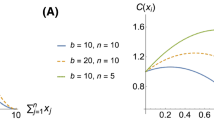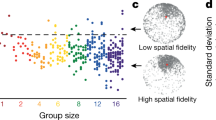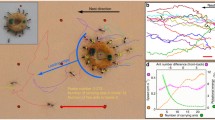Summary
Social animals exchange information during social interaction. The rate of interaction and, hence, the rate of information exchange, typically changes with density and density may be affected by the size of the social group. We investigate models in which each individual may be engaged in one of several tasks. For example, the different tasks could represent alternative foraging locations exploited by an ant colony. An individual's decision about which task to pursue depends both on environmental stimuli and on interactions among individuals. We examine how group size affects the allocation of individuals among the various tasks. Analysis of the models shows the following. (1) Simple interactions among individuals with limited ability to process information can lead to group behaviour that closely approximates the predictions of evolutionary optimality models, (2) Because per capita rates of social interaction may increase with group size, larger groups may be more efficient than smaller ones at tracking a changing environment, (3) Group behaviour is determined both by each individual's interaction with environmental stimuli and by social exchange of information. To keep these processes in balance across a range of group sizes, organisms are predicted to regulate per capita rates of social interaction and (4) Stochastic models show, at least in some cases, that the results described here occur even in small groups of approximately ten individuals.
Similar content being viewed by others
References
Adams, E.S. (1990) Boundary disputes in the territorial antAzteca trigona: effects of asymmetries in colony size.Anim. Behav. 39 321–8.
Adler, F.R. and Gordun, D.M. (1992) Information collection and spread by networks of patrolling ants.Am. Nat. 40 373–400.
Brown, J.L. (1982) Optimal group size in territorial animals.J. Theor. Biol. 95 793–810.
Calabi, P. (1988) Behavioral flexibilty in Hymenoptera: a reconsideration of the concept of caste. InAdvances in Myrmecology. (J.C. Trager eds.) pp. 237–58. E.J. Brill, New York.
Caraco, T. (1979) Time budgeting and group size: a theory.Ecology 61 611–17.
Caraco, T. (1980) On foraging time allocation in a stochastic environment.Ecology 61 119–28.
Cartar, R.V. (1992) Adjustment of foraging effort and task switching in energy-manipulated wild bumblebee colonies.Anim Behav. 44 75–87.
Cole, B.J. (1992) Short-term activity cycles in ants: age-related changes in tempo and colony synchrony.Behav. Ecol. Sociobiol. 31 181–7.
Deneubourg, J.L., Aron S., Goss, S., Pasteels, J.M. and Duernick, G. (1986) Random behaviour, amplification processes and number of participants: how they contribute to the foraging properties of ants.Physica D 22 176–86.
Deneubourg, J.L. and Goss, S. (1989) Collective patterns and decision making.Ethol. Ecol. Evol. 1 295–311.
Deneubourg, J.L., Aron, S., Goss, and Pasteels, J.M. (1990) The self-organizing exploratory pattern of the Argentine ant.J. Insect Behav. 31 159–168.
Franks, N.R., Bryant, S. and Griffiths, R. (1990) Synchronization of the behaviour within nests of the antLeptothorax acervorum (Fabricius) — I. Discovering the phenomenon and its relation to the level of starvation.Bull. Math. Biol. 52 597–612.
Fretwell, S.D. and Lucas, H.J. (1970) On territorial behavior and other factors influencing habitat distribution in birds.Acta Biotheor. 19 16–36.
Giraldeau, L.A. and Gillis, D. (1985) Optimal group size can be stable: a reply to Sibly.Anim. Behav. 33 666–7.
Gordon, D.M. (1986) The dynamics of the daily round of the harvester ant colony.Anim. Behav. 34 1402–19.
Gordon, D.M. (1986) Group-level dynamics in harvester ants: young colonies and the role of patrolling.Anim. Behav. 35 833–43.
Gordon, D.M. (1989) Dynamics of task switching in harvester ants.Anim. Behav. 381 194–204.
Gordon, D.M. (1991) Behavioral flexibility and the foraging ecology of seed-eating ants.Am. Nat. 138 379–411.
Gordon, D.M. (1992) How colony growth affects forager intrusion in neighboring harvester ant colonies.Behav. Ecol. Sociobiol. 31 417–27.
Gordon, D.M., Goodwin, B. and Trainor, L.E.H. (1992) A parallel distributed model of ant colony behaviour.J. Theor. Biol. 156 293–307.
Gordon, D.M., Paul, R.E.H. and Thorpe, K. (1993) What is the function of encounter patterns in ant colonies?Anim. Behav. 45 1083–100.
Holldobler, B. (1981) Foraging and spatiotemporal territories in the honey antMyrmecocystus mimicus Wheeler (Hymenoptera: Formicidae).Behav. Ecol. Sociobiol. 9 301–14.
Huang, Z.Y. and Robinson, G.E. (1992) Honeybee colony integration: worker—worker interactions mediate hormonally regulated plasticity in division of labor.Proc. Nat. Acad. Sci. USA 89 11726–9.
Jaisson, P., Fresneau, D., Lauchard, J.-P. (1988) InInterindividual Variablity in Social Insects. (R.L. Jeanne) pp. 1–52, Boulder, Westview Press.
Jeanne, R.L. (1986) The organization of work inPolybia occidentalis: the costs and benefits of specialization in a social wasp.Behav. Ecol. Sociobio. 19 333–41.
Jeanne, R.L. (1987) Do water foragers pace nest construction activity inPolybia occidentalis? Experientia54 (Suppl.), 241–51.
Kramer, D.L. (1985) Are colonies supraoptimal groups?Anim. Behav. 33 1031.
Nonacs, P. and Dill, L.M. (1990)Mortality risk versus food quality trade-offs in a common currency: ant patch preferences.Ecology 71 886–92.
Nonacs, P. and Dill, L.M. (1991) Mortality risk versus food quality trade-offs in ants: patch use over time.Ecol. Entomol. 16 73–80.
Oster, G. and Wilson, E.O. (1978)Caste and Ecology in Social Insects. Princeton University Press, Princeton, N.J.
Packer, C., Sheel, D. and Pusey, A.E. (1990) Why lions form groups: food is not enough.Am. Nat. 136 1–19.
Pasteels, J.M., Deneubourg, J.-L., Goss, S. (1987) Self-organization mechanisms in ant collective societies (I): trail recruitment to newly discovered food sources. InFrom Individual to collective behavior in social insects. (J.M. Pasteels and J.-L. Deneubourg eds.) pp. 155–75. Basel, Birkhauser.
Pasteels, J.M., Deneubourg, J.-L., Goss, S. (1988). Transmission and amplification of information in a changing environment: the case of insect societies. InLaw of nature and human conduct. (I. Prigogine and M. Sanglier eds.) pp. 129–56, G.O.R.D.E.S., Bruxelles
Pulliam, H.R. (1973) On the advantages of flocking.J. Theor. Biol. 38 419–22.
Robinson, G.E. (1992) Regulation of division of labor in insect societies.Ann. Rev. Entomol. 37 637–702.
Schmid-Hempel, P. (1990) Reproductive competition and the evolution of work load in social insects.Am. Nat. 135 501–26.
Schneider, S.S. (1986) The vibration dance activity of successful foragers of the honeybee,Apis mellifera (Hymenoptera: Apidae).J. Kansas Entomol. Soc. 59 699–705.
Seeley, T.D. (1986) Social foraging by honeybees 2. How colonies allocate foragers among patches of flowers.Behav. Ecol. and Sociobiol. 19 343–54.
Seeley, T.D. (1989) Social foraging in honey bees: how nectar foragers assess their colony's nutritional status.Behav. Ecol. Sociobiol. 24 181–99.
Seeley, T.D., Camazine, S. and Sneyd, J. (1991) Collective decision-making in honey bees: how colonies choose among nectar sources.Behav. Ecol. Sociobiol. 28 277–90.
Topoff, H. and Mirenda, J. (1978) Precocial behaviour of callow workers of the army antNeivamyrmex nigrescens: importance of stimulation by adults during mass recruitment.Anim. Behav. 26 698–706.
Tschinkel, W.R. (1988) Colony growth and the ontogeny of worker polymorphism in the fire ant,Solenopsis invicta.Behav. Ecol. Sociobiol. 22 103–15.
Waser, P. (1984) ‘Chance’ and mixed-species associations.Behav. Ecol. Sociobiol. 15 197–202.
Wilson, E.O. (1962) Chemical communication among workers of the fire antSolenopsis saevissima (Fr. Smith) 1. The organization of mass foraging.Anim. Behav. 10 134–47.
Wilson, E.O. (1971)The Insect Societies. Harvard University Press. Cambridge, MA.
Wolf, T.J. and Schmid-Hempel, P. (1990) On the integration of individual foraging strategies with colony ergonomics in social insects: nectar-collection in honeybees.Behav. Ecol. Sociobiol. 27 103–11.
Author information
Authors and Affiliations
Rights and permissions
About this article
Cite this article
Pacala, S.W., Gordon, D.M. & Godfray, H.C.J. Effects of social group size on information transfer and task allocation. Evol Ecol 10, 127–165 (1996). https://doi.org/10.1007/BF01241782
Issue Date:
DOI: https://doi.org/10.1007/BF01241782




